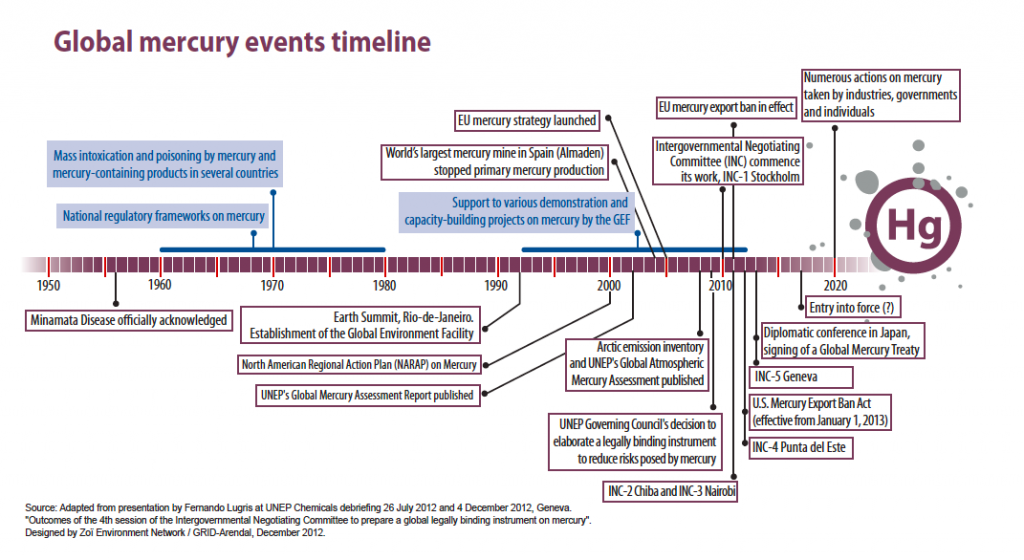By Ellen Czaika and Bethanie Edwards
In preparing this blog post, we used information from Brooks’s 2012 chapter in Mercury in the Environment and Nriagu’s 1979 The Biogeochemistry of Mercury in the Environment, unless otherwise noted.
As with most elements, there is a fixed amount of mercury on the planet. This mercury cycles through the deep earth, the atmosphere, the terrestrial reservoir, and various water bodies on timescales that vary from less than a year to tens of thousands of years. Toxicity aside, mercury has many chemical properties that make it useful to humans. Thus, there is evidence that mercury has been utilized throughout antiquity. A human skeleton dating from 5000BCE was found covered in vermillion, also known as cinnabar (HgS). Another historic example of mercury use was found in a 15th century BCE Egyptian tomb ceremonial cup.
Humans have been mining mercury ore from the deep earth (the “lithosphere”) since at least the Roman times. The Romans operated a mercury mine in Spain with prisoner and slave labor. They used mercury as a pigment in their paint; mercury-containing paint has been found in Roman homes buried by the volcanic ash of Mount Vesuvius in 79CE. The use of mercury in paint has continued into the modern area, although in recent history, mercury was added as a fungicide rather than for its chromatic properties. It wasn’t until 1991 that the use of mercury in paint was phased out in the US.
Aristotle is credited with the oldest known written record of mercury (in an academic text dating back to sometime during the 4th century BCE), in which he referred to it as “fluid silver” and “quicksilver.” This academic text conveyed what alchemists of his day believed: that mercury was the component in all metals that gave them their “metal-ness.” At that time, it was used in ceremonies and to treat skin disorders. In India and China, it was used as an aphrodisiac and for medical therapy circa 500 BCE. Chinese woman are reported to have consumed mercury as a contraceptive 4,000 years ago. Cinnabar is still used as a sedative in traditional Chinese medicine.
By 1000 CE, mercury was used to extract gold by amalgamation. The mercury surrounds the gold, forming shiny pellets that workers then burn. The mercury evaporates, leaving the purified gold. This process is still practiced by artisanal small-scale gold mining operations today, exposing over 10 million of workers to the toxic element and releasing between 650-1000 tonnes of mercury per year into the environment.
Mercury was used in scientific research largely as a result of Torricelli’s 1643 invention of the barometer and Fahrenheit’s 1720 invention of the mercury thermometer. While thermometers in the health care sector are no longer made with mercury, China still produces several measurement devices, such as blood-pressure meters, that contain mercury.
During the Industrial Revolution, various inventions increased the demand for mercury. In 1799, mercury fulminate was first used as a detonator for explosives. In 1835, polyvinyl chloride (PVC) was first produced, the original synthesis of which relied on mercury as a catalyst. In 1891, Thomas Edison’s incandescent lamp contained mercury (to this day compact fluorescent light bulbs have mercury added to them.) In 1894, H.Y. Castner discovered that mercury could be used in the chlor-alkali process to produce chlorine and caustic soda. And during WWII, the Ruben-Mallory battery (mercury dry-cell battery) was invented and widely used.
By the early 1900s, the main uses of mercury were in making scientific equipment, recovering gold and silver, manufacturing fulminate and vermilion, and felt-making. Of note, individuals who made felt hats displayed signs of dementia as a result of mercury poisoning. These “Mad Hatters” were referred to by Lewis Carroll in his book Alice in Wonderland.
By the 1960s, the production of electrical apparati, caustic soda, and chlorine accounted for over 50% of mercury uses. Caustic soda is largely associated with the paper industry; it is used to achieve whiter paper. With the exception of manufactures in China, chlor-alkali production has now shifted to a non-mercury method. However, the chlor-alkali industry still accounts for 1% of total mercury emissions to the atmosphere and potentially a much larger contribution to water and land releases.
Before 1850, the world’s supply of usable mercury was extracted from three mines located in Almaden, Spain (dating back to the Romans times); Idria, Slovenia; and Santa Barbara, Peru (which the Spanish controlled during colonial times). Between 1850 and the 1960’s, the Santa Barbara mine ceased production and mercury mining began in two other regions: in Monte Amiata, Italy, and throughout California in the United States. The latter coincided with the Gold Rush. Since 1960, other mines have opened in the Soviet block countries, China, Kazakhstan, Algeria, Mexico, and the US state of Nevada. Despite the opening of new mines in recent decades, a report from the EU predicts that recycling of mercury from products and by-products could help meet the mercury demand and further reduce direct mining of mercury.
The historical use of mercury has set the stage for many of the modern products and processes that utilize mercury. It is estimated that, over the last 4000 years, historical and continued use of mercury have released 350,000 tonnes of mercury from the depths of the earth into air, surface land, and water, where it’s toxicity becomes problematic for human health and Earth’s sensitive biosphere.
Humans have been using mercury for various uses for much of history. These uses prompt mining and other ways of making mercury available. Given its long persistence and dangers to health and the environment, it is essential we figure out how to reduce mercury uses and anthropogenic releases. Because mercury is a trans-boundary traveller, coordination and negotiation at the international level are essential.

